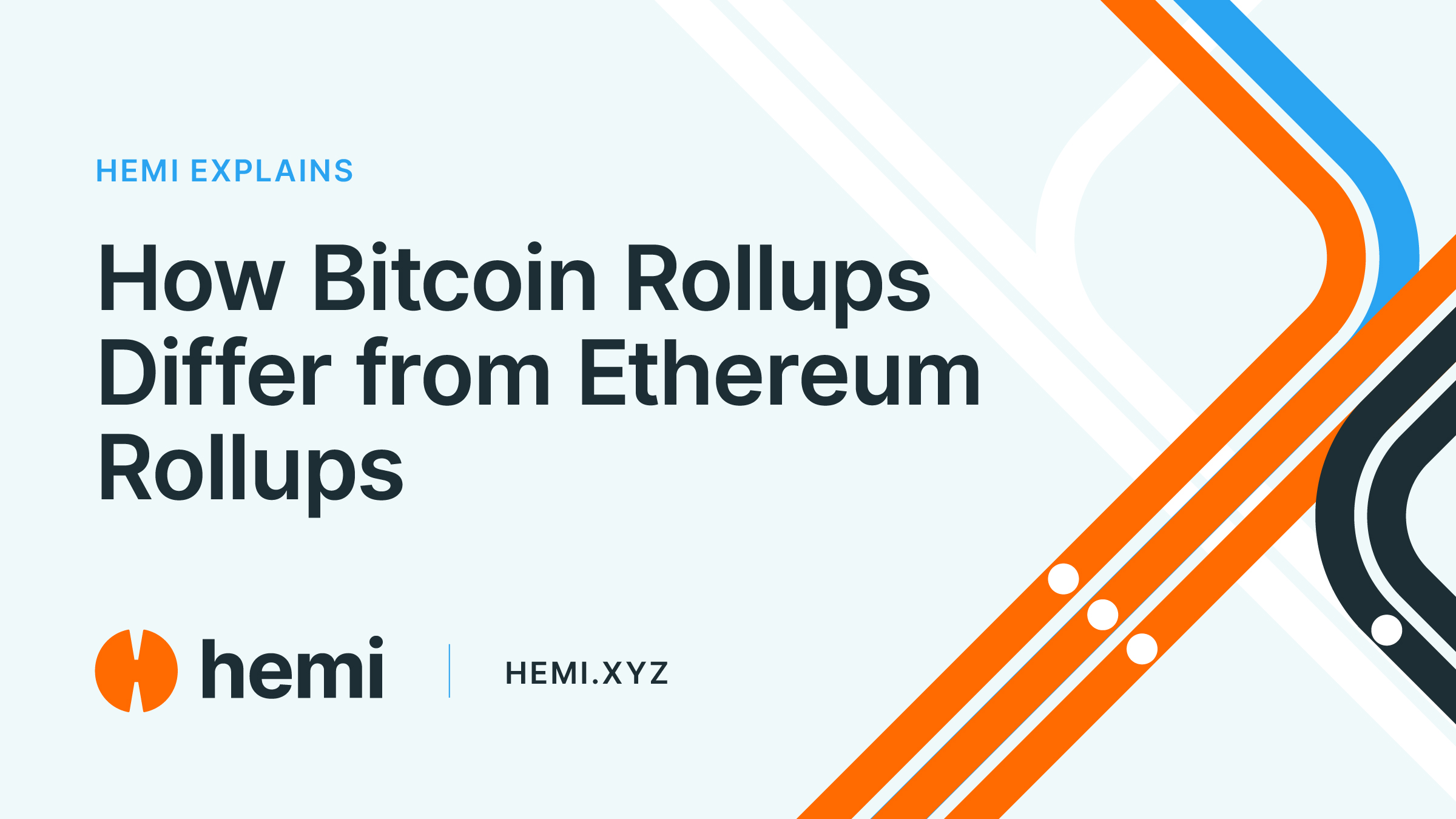- Bitcoin
- Ethereum
- Hemi
- Learn Center
- July 12, 2025
How Bitcoin Rollups Differ from Ethereum Rollups
Both types of rollups speed up transactions. But how do they differ?

Rollups help speed up and cheapen transactions on big blockchains. On Ethereum, they’re the usual way to do this. On Bitcoin, rollups are newer and quite different. Let’s look at how.
What Are Rollups?
Rollups are tools that gather many transactions together and send them to the main blockchain. This makes transactions cheaper, faster, and keeps most of the work off the main chain, while still using its security.
There are two main kinds:
- Optimistic rollups trust that transactions are good unless someone proves otherwise.
- ZK rollups use special math proofs to show transactions are good right away.
Ethereum uses both. Bitcoin rollups, though, work differently.
Ethereum Rollups: Built for Smart Contracts
Ethereum is designed with a full-featured computer (EVM) and smart contracts (agreements written in code). This lets rollups:
- Use complex code on the blockchain to prove or dispute transactions.
- Link their data and operations directly to Ethereum.
- Use Ethereum’s computer to check proofs and manage how money moves between layers.
Because of this, Ethereum rollups are tightly linked to the main Ethereum chain. They rely on Ethereum’s ability to run code to keep track of information and solve problems.
Bitcoin Rollups: Very Little On-Chain Code
Bitcoin rollups can’t use smart contracts in the same way. Bitcoin’s main chain is kept simple on purpose. It doesn’t allow general computer programs or smart contracts.
This means Bitcoin rollups:
- Don’t run code on the main chain: They don’t check proofs there.
- Rely on off-chain checks: Proofs of valid or fraudulent transactions are checked off the main chain.
- Use clever ways to share data: They post batches of transaction data to Bitcoin using methods like `OP_RETURN`, Taproot, or witness data.
Bitcoin rollups use Bitcoin to timestamp and finalize data, but they rely on Layer 2 methods for trust.
Data Availability: A Key Difference
Ethereum rollups can put all transaction data on the main chain, so anyone can see and check it.
Bitcoin isn’t designed this way. Bitcoin rollups have to use other ways to make data available, such as:
- Taproot-based linking.
- Separate data availability layers.
- Bundled data through SegWit.
This changes how trust works. Ethereum rollups get full data availability from Ethereum. Bitcoin rollups might depend on other systems or combine different methods.
Security Models: Ethereum vs. Bitcoin
Ethereum rollups use Ethereum’s security. Smart contracts handle disputes and withdrawals. Users can move their assets back to the main Ethereum chain freely.
Bitcoin rollups can’t do this. Instead:
- Exiting might need coordination (e.g., multiple signatures, time limits).
- Fraud or validity proofs aren’t checked by the main chain.
- Bridges use less-trusting methods, not contracts.
Some Bitcoin rollups use special signatures or Proof-of-Proof systems to reduce the need for trust. But these ideas are still developing.
Examples of Bitcoin Rollups
Several projects are building Bitcoin-specific rollups:
- Hemi uses a flexible Proof-of-Proof design to handle Bitcoin-based finance and apps, with secure ways to move assets and custom virtual machines.
- Botanix is making a rollup that works with Ethereum’s computer (EVM) but links to Bitcoin.
- Rollkit helps with testing rollups on Bitcoin using independent data availability and flexible execution layers.
Each of these has to work within Bitcoin’s rules without sacrificing its core values of decentralization or finality.
Ethereum rollups are deeply connected to its smart contract system. Bitcoin rollups work around Bitcoin’s limits, focusing on simplicity, resistance to censorship, and flexibility.
This means Bitcoin rollups:
- Don’t rely on the main chain to check for fraud or validity.
- Use different ways of establishing trust and moving assets.
- Work in a more flexible, off-chain way.
As Bitcoin’s Layer 2 technology grows, expect these two ecosystems to become even more distinct, not more similar.